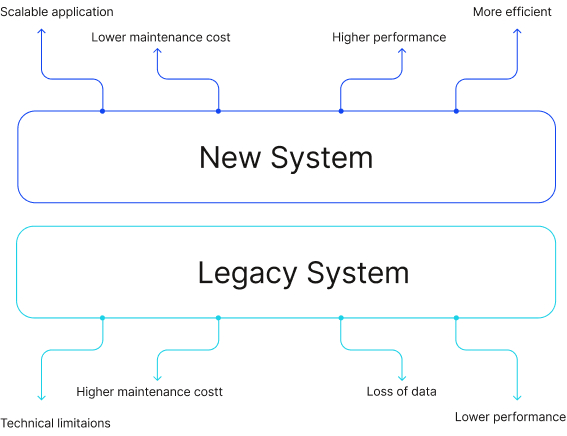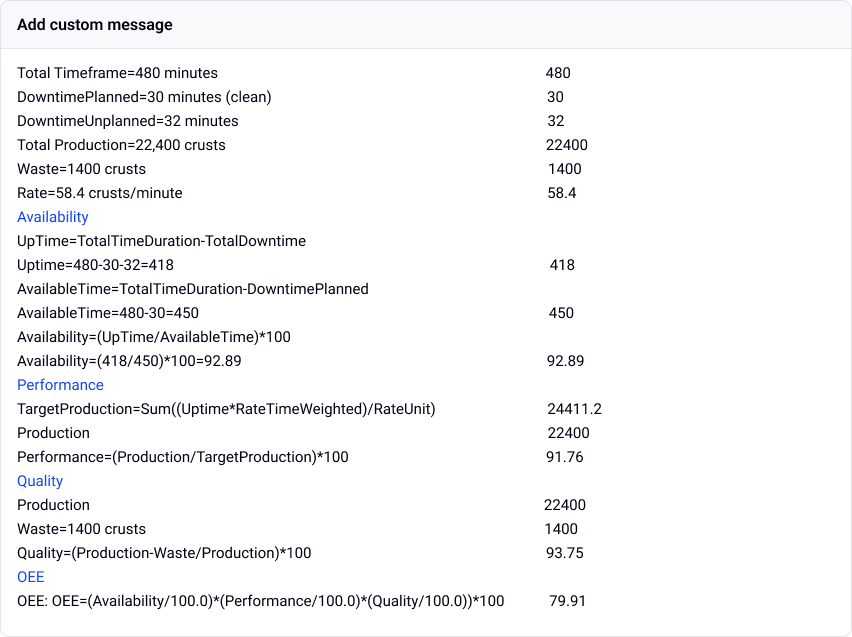The Path to Efficiency: Strategies for Successful OEE Monitoring Software Implementation in Manufacturing
Blog
4 Min Read
In the complex world of manufacturing, businesses are under constant pressure to enhance efficiency, improve productivity, and increase profitability. To meet these objectives, it’s crucial to have an accurate gauge of the effectiveness of your manufacturing equipment and personnel. A metric that stands at the forefront of such an evaluation is Overall Equipment Effectiveness, or OEE.
OEE is an all-encompassing performance metric that objectively measures the efficiency of your production processes. The concept may sound intricate, but understanding and employing it can unlock profound improvements in operational efficiency. Let’s delve into the world of OEE, its components, benefits, calculation, and interpretation in this article.

Unraveling the Concept of OEE
OEE is a gold standard in manufacturing, providing insights that can bridge the gap between the actual and potential output. It does so by integrating three separate but intertwined metrics: Availability, Performance, and Quality. The ultimate objective of OEE analysis is to strive for a perfect score of 100% in all these areas, implying your operation is running at its full potential – maximum quality, speed, and uptime.
OEE Calculation: Breaking it Down
While OEE might sound complex, calculating it is relatively straightforward. At its core, OEE is computed using the formula:
OEE = Availability * Performance * Quality
Each component of this equation is expressed as a percentage, and the end result is a single number, also expressed as a percentage. The closer this number is to 100%, the higher the overall equipment effectiveness.
- Availability
This measures the proportion of scheduled time that the operation is available to produce. Availability takes into account both planned and unplanned stops, including downtime due to equipment failures, maintenance, line changeovers, and external factors such as the unavailability of input materials.
- Performance
Performance reflects the speed at which your equipment operates compared to its optimal or target speed. It accounts for losses arising from running the equipment at speeds below the target rate. The ideal performance rate is defined as the best demonstrated instantaneous rate at which a product can run through the system’s chokepoint.
- Quality
Quality measures the ability of the equipment to produce defect-free output on the first pass. It takes into account losses resulting from scrap, rework, in-process damage, and out-of-spec production.
In essence, OEE aggregates these factors into a single percentage, providing a clear and comprehensive snapshot of how effectively your manufacturing equipment is being utilized.
The Compelling Benefits of OEE
The beauty of OEE lies in its power to translate complex operational data into actionable insights. OEE serves as a cornerstone for continuous improvement strategies, pinpointing inefficiencies and facilitating precise decision-making for performance enhancement.
In fact, a minor improvement in OEE can translate into substantial cost savings.
Notice that all of the components of the OEE calculation are in the context of time. The OEE calculation takes into account the time-related aspects of equipment performance, production, and downtime. By incorporating time-related measurements into the OEE calculation, manufacturers can assess the utilization of their equipment over a specific timeframe, identify bottlenecks, and target areas for improvement to optimize productivity and minimize downtime.

Deciphering OEE Scores
Though OEE is primarily a relative measure used to monitor changes over time, certain benchmarks can provide a high-level understanding of operational efficiency:
- OEE < 65%: This level of OEE is typically seen in companies that are just starting to track their operational efficiency. Immediate intervention and actions are required for improvement.
- OEE 65 – 75%: This is often considered as a satisfactory zone, but continuous improvement efforts should be in place to push the OEE higher.
- OEE > 75%: This is a good OEE score, indicating a reasonably efficient operation.
- OEE > 85%: Achieving an OEE above 85% is considered world-class, demonstrating an outstanding level of operational efficiency.
The Role Key Stakeholders when it comes to OEE
To stay competitive in today’s fast-paced market, companies must optimize their operations and utilize their resources effectively. Overall Equipment Efficiency (OEE) is an essential tool that enables this optimization. OEE provides valuable insights into how well equipment is utilized, enabling stakeholders to identify bottlenecks, streamline processes, and enhance productivity. In this blog post, we will explore the significance of OEE and the key stakeholders who benefit from its implementation in a manufacturing facility.
- Plant Managers/Operations Managers:
Plant managers and operations managers have the responsibility of overseeing the entire manufacturing facility. Their primary concern is achieving optimal performance and efficiency. OEE is a critical metric for them, offering a comprehensive overview of equipment effectiveness and resource utilization. By closely monitoring OEE, these managers can identify areas of improvement, make informed decisions, and implement strategies to maximize productivity. - Production Supervisors/Team Leaders:
Production supervisors and team leaders play a crucial role in managing daily operations on the shop floor. Their focus lies in maintaining smooth production processes and meeting production targets. OEE provides them with real-time insights into the performance of individual production lines, machines, or work cells. By analyzing OEE data, they can identify underperforming assets, address bottlenecks, and allocate resources effectively. This empowers them to make data-driven decisions, optimize production schedules, and enhance overall efficiency. - Maintenance Technicians/Engineers:
Maintenance technicians and engineers are responsible for equipment upkeep and ensuring smooth operations. For them, OEE acts as a diagnostic tool to monitor machine performance. By analyzing OEE metrics, they can detect patterns of equipment malfunctions or breakdowns that hinder production. OEE data helps maintenance teams plan preventive maintenance, schedule repairs, and reduce unplanned downtime. By proactively addressing equipment issues, they contribute to increased OEE and improved overall efficiency. - Continuous Improvement/Lean Manufacturing Teams:
Continuous improvement and lean manufacturing teams are dedicated to driving process enhancements within the manufacturing facility. OEE serves as a crucial benchmark for their initiatives. By analyzing OEE data, these teams can identify areas for improvement, implement lean techniques, and track the impact of their actions. OEE acts as a performance indicator, allowing them to evaluate the success of their continuous improvement efforts. Through OEE-driven optimization, these teams strive for increased productivity and reduced waste. - Quality Control/Assurance Personnel:
Maintaining product quality is paramount for manufacturing facilities. Quality control and assurance personnel utilize OEE to evaluate its impact on product quality. By monitoring OEE metrics, they can assess how equipment performance influences quality. OEE helps them identify potential areas where quality issues may arise due to machine inefficiencies. Armed with this information, they can take corrective actions, enhancing both production efficiency and product quality.
Best Practices for Manufacturing Facilities with OEE
By measuring availability, performance, and quality, OEE provides valuable insights into areas of improvement. In this blog, we will explore the best practices that manufacturing facilities can implement to maximize their OEE and drive productivity to new heights.
- Set Clear Objectives:
To begin the journey towards improved OEE, it is crucial to set clear objectives. Align these goals with the overall business objectives of the facility. Whether it’s reducing downtime, enhancing equipment performance, or improving product quality, defining specific targets will provide focus and direction. - Measure and Track OEE:
Implementing a systematic method for measuring and tracking OEE is essential. Collect data on availability, performance, and quality metrics for each equipment or process. Utilize modern technology to automate data collection and establish a centralized system for storing and analyzing this information. - Identify and Analyze Losses:
Uncover the major causes of equipment downtime, production slowdowns, and quality defects. Analyze the collected data to identify root causes and prioritize improvement efforts accordingly. Whether it’s equipment breakdowns, inefficient changeovers, or inadequate maintenance practices, understanding the losses is key to addressing them effectively. - Implement Total Productive Maintenance (TPM):
Total Productive Maintenance (TPM) practices are vital for improving equipment reliability, reducing downtime, and extending equipment life. Regular preventive maintenance, operator involvement in maintenance activities, and continuous equipment monitoring can significantly enhance equipment performance and availability. - Optimize Changeover and Setup Times:
Lengthy changeover and setup times can hinder productivity. By streamlining these processes, manufacturers can minimize equipment idle time and maximize overall equipment performance. Standardize work procedures, invest in efficient tooling, and design equipment for quick changeovers to reduce setup times and boost productivity. - Implement Continuous Improvement Initiatives:
To foster a culture of continuous improvement, involve employees in problem-solving and process optimization activities. Utilize methodologies such as Kaizen, Lean manufacturing, and Six Sigma to identify and eliminate waste and variability. Encourage employees to suggest improvements and provide them with the necessary training and tools to contribute effectively. - Enhance Workforce Skills and Training:
Invest in training programs to improve the skills and knowledge of employees involved in operating and maintaining equipment. Equip them with a deep understanding of OEE and its significance. Empowered and knowledgeable employees are more likely to actively contribute to OEE improvement initiatives. - Enhance Workforce Skills and Training:
Invest in training programs to improve the skills and knowledge of employees involved in operating and maintaining equipment. Equip them with a deep understanding of OEE and its significance. Empowered and knowledgeable employees are more likely to actively contribute to OEE improvement initiatives. - Implement Real-time Monitoring and Visualization:
Leverage advanced technologies like Industrial IoT and data analytics to monitor equipment performance in real-time. By implementing real-time monitoring systems, manufacturers can identify performance gaps promptly, allowing for swift corrective actions. Display OEE metrics and performance data on dashboards throughout the facility to create visibility and promote awareness. - Establish Performance Metrics and Accountability:
Define key performance indicators (KPIs) related to OEE and establish accountability for meeting these targets. Regularly review performance against these targets and provide feedback to employees and teams. By fostering a culture of accountability, everyone becomes actively involved in driving OEE improvements. - Foster Collaboration and Communication:
Promote cross-functional collaboration between production, maintenance, engineering, and quality teams. Encourage open lines of communication and ensure timely information sharing. By fostering a collaborative environment, organizations can address OEE-related issues collectively, leveraging diverse perspectives and expertise.
Based on the example data provided, let’s break down the calculation of the different components of OEE: - Availability:
The total timeframe is given as 480 minutes. Planned downtime for cleaning is 30 minutes, and unplanned downtime is 32 minutes. To calculate the uptime, subtract the total downtime from the total time duration: 480 – 30 – 32 = 418 minutes. The available time is calculated by subtracting the planned downtime from the total time duration: 480 – 30 = 450 minutes. The availability is then determined by dividing the uptime by the available time and multiplying by 100: (418 / 450) * 100 = 92.89%. - Performance:
The target production is calculated using the formula: Sum((Uptime * RateTimeWeighted) / RateUnit). In this case, the target production is 24,411.2 crusts. The actual production is given as 22,400 crusts. To calculate performance, divide the actual production by the target production and multiply by 100: (22,400 / 24,411.2) * 100 = 91.76%. - Quality:
The production is given as 22,400 crusts, and the waste is 1,400 crusts. To calculate the quality, subtract the waste from the production, divide by the production, and multiply by 100: ((22,400 – 1,400) / 22,400) * 100 = 93.75%. - OEE:
Finally, the OEE is calculated by multiplying the availability, performance, and quality percentages together and dividing by 100: (92.89 / 100) * (91.76 / 100) * (93.75 / 100) * 100 = 79.91%.
In this example, the OEE for the given data is 79.91%. OEE provides a comprehensive view of equipment effectiveness, taking into account availability, performance, and quality metrics, allowing manufacturers to identify areas for improvement and maximize operational efficiency.
Benefits of OEE Monitoring Software:
- Real-time Visibility:
OEE monitoring software collects and displays real-time data on equipment performance, production rates, downtime, and quality metrics. This visibility allows operators and managers to quickly identify issues and take corrective actions promptly, minimizing disruptions and maximizing productivity. - Data Analysis and Insights:
OEE software aggregates and analyzes data from multiple sources, helping to identify patterns, trends, and root causes of inefficiencies. With data-driven insights, manufacturers can make informed decisions to optimize equipment utilization, improve processes, and reduce downtime. - Performance Benchmarking:
OEE monitoring software provides benchmarking capabilities, allowing manufacturers to compare equipment performance across different shifts, lines, or facilities. Benchmarking helps identify best practices, set performance targets, and drive healthy competition to continuously improve OEE. - Automated Reporting:
OEE software automates the generation of reports and performance dashboards, eliminating manual data collection and analysis. Automated reporting saves time, improves accuracy, and enables regular monitoring of OEE metrics, facilitating effective communication and decision-making. - Predictive Maintenance:
Advanced OEE monitoring software leverages predictive analytics and machine learning algorithms to anticipate equipment failures and maintenance needs. By proactively addressing potential issues, manufacturers can reduce unplanned downtime and improve overall equipment reliability.
Elements of OEE Monitoring Software
OEE monitoring software typically consists of several key elements that work together to enable effective tracking, analysis, and visualization of OEE metrics. The specific features and functionalities may vary among different software solutions, but here are some common elements found in OEE monitoring software:
Benefits of OEE Monitoring Software:
- Data Collection:
The software collects data from various sources, such as sensors, machines, control systems, and manual inputs. It captures information on equipment uptime, downtime, production counts, cycle times, quality data, and other relevant parameters. - Real-time Monitoring:
OEE monitoring software provides real-time monitoring capabilities, displaying live data on dashboards and visualizations. Operators and managers can easily track equipment performance, downtime events, production rates, and other critical metrics at any given moment. - Performance Calculation:
The software calculates OEE and its components (availability, performance, and quality) based on the collected data. It uses predefined algorithms or customizable formulas to perform these calculations accurately. - Visualization and Reporting:
OEE monitoring software offers visualizations, charts, graphs, and customizable reports to present OEE metrics and performance trends. Users can generate reports automatically or on-demand, allowing for in-depth analysis, comparison, and communication of OEE data. - Historical Data Analysis:
The software stores and maintains historical data, allowing users to analyze trends, patterns, and performance over time. Historical analysis helps identify recurring issues, seasonal variations, and improvement opportunities. - Alerts and Notifications:
OEE monitoring software can generate alerts and notifications when certain conditions or thresholds are met. This feature helps users quickly identify anomalies, equipment failures, or performance deviations, enabling timely intervention and corrective actions. - Performance Benchmarking:
Some software solutions offer benchmarking capabilities, allowing manufacturers to compare equipment performance against industry standards, best practices, or internal targets. Benchmarking helps set realistic goals, identify performance gaps, and drive continuous improvement initiatives. - Integration with Existing Systems:
OEE monitoring software often integrates with existing equipment, control systems, or enterprise resource planning (ERP) systems. This integration ensures seamless data flow between different software platforms and enables a holistic view of operations - Predictive Analytics:
Advanced OEE monitoring software may incorporate predictive analytics algorithms to anticipate equipment failures, maintenance needs, or production bottlenecks. Predictive analytics helps optimize maintenance schedules, reduce downtime, and improve overall equipment effectiveness. - User-Friendly Interface:
OEE monitoring software typically features an intuitive and user-friendly interface, making it easy for operators, managers, and other stakeholders to navigate, access data, and perform analysis. The interface may be customizable to meet specific user preferences and roles.
These elements work together to provide manufacturers with comprehensive visibility into equipment performance, downtime analysis, and quality metrics, enabling them to make data-driven decisions, optimize processes, and drive continuous improvement.
Overall Equipment Efficiency (OEE) is a vital tool for manufacturing facilities seeking to maximize productivity and optimize resource utilization. By providing valuable insights into equipment performance, OEE empowers key stakeholders to make data-driven decisions, identify improvement opportunities, and enhance overall efficiency. From plant managers and production supervisors to maintenance technicians, continuous improvement teams, and quality control personnel, each stakeholder plays a crucial role in leveraging OEE to drive operational excellence. By embracing OEE and its potential, manufacturing facilities can stay ahead in a highly competitive landscape, ensuring sustainable growth and success.
Read more about The Key to Manufacturing Efficiency in our blog on Understanding OEE.

Agile MES: The Key to Unlocking Smart Manufacturing Success
MES is a computerized system used in manufacturing operations to track and document the transformation of raw materials into finished goods. An MES system typically manages and monitors work orders, equipment, materials, and personnel on the shop floor. The system provides real-time visibility into production processes, helps optimize manufacturing operations, and improves the overall efficiency of the manufacturing process.

Understanding OEE: The Key to Manufacturing Efficiency
In today’s competitive manufacturing landscape, improving efficiency and productivity is crucial for businesses to remain competitive. One of the key metrics used to measure manufacturing efficiency is OEE or Overall Equipment Effectiveness. In this blog, we will take a closer look at OEE and its importance in manufacturing.

How to Effectively Conduct a Legacy System Integration
Legacy system integration can be a daunting task, but it’s a necessary one for many manufacturers that rely on outdated systems to run their business. Integrating legacy systems with modern technology can improve efficiency, streamline processes, and save time and money. However, it’s important to approach the integration process carefully and methodically to ensure success.
Share on :
Keep On Reading
Subscribe to Our Newsletter
Subscribe to our weekly newsletters to get updates regarding our new production, behind the scene process of our art creation and much more.
After submitting this form you will receive an e-mail with a confirmation link that you must click to complete your request. Detailed information on processing and cancellation can be found in our privacy policy.



